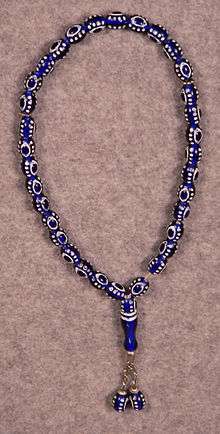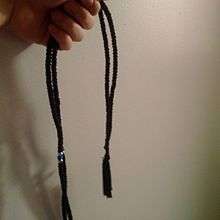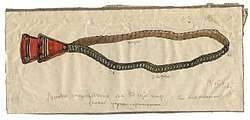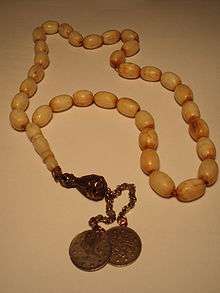Prayer beads
Prayer beads are used by members of various religious traditions such as Hinduism, Buddhism, Christianity, Islam, Sikhism and the Bahá'í Faith to mark the repetitions of prayers, chants or devotions, such as the rosary of the Blessed Virgin Mary in Catholicism, and dhikr (remembrance of God) in Islam.
Origins and etymology
Beads are among the earliest human ornaments and ostrich shell beads in Africa date to 10,000 BC.[1] Over the centuries various cultures have made beads from a variety of materials from stone and shells to clay.[1]
The English word bead derives from the Old English noun bede which means a prayer.[2][3][4][5] The oldest image of a string of beads in a religious context and resembling a string of prayer beads is found on the fresco of the "Adorants" (or "Worshipers") at the Xeste 3 building of the prehistoric settlement of Akrotiri, Santorini (Thera,) Greece (Wall Paintings of Thera.) [6] dating from the 17th c. BC (c. 1613 BC.) The exact origins of prayer beads remain uncertain, but their earliest historical use probably traces to Hindu prayers in India.[1][3][7] Buddhism probably borrowed the concept from Hinduism.[1][3] The statue of a holy Hindu man with beads dates to the third century BC.[3][7]
Structure

The number of beads varies by religion or use. Islamic prayer beads, called Misbaha or Tasbih, usually have 100 beads (99 +1 = 100 beads in total or 33 beads read thrice and +1. Buddhists and Hindus use the Japa Mala, which usually has 108 beads, or 27 which are counted four times. Baha'i prayer beads consist of either 95 beads or 19 beads, which are strung with the addition of five beads below. The Sikh Mala also has 108 beads.
Roman Catholics use the Rosary (Latin "rosarium", meaning "rose garden") with 59 beads. However, Eastern Orthodox Christians use a knotted prayer rope called either a komboskini or chotki, with 100 knots, although prayer ropes with 50 or 33 knots can also be used. In Vita of Saint Paul of Thebes (227 A.D. to 342 A.D.), written by Saint Jerome (347 A.D. to 420 A.D.) it states that Saint Paul of Thebes used pebbles and knotted cord to count prayers. [8] Although Anglo-Catholics have used the Dominican rosary since the 19th century, in the 1980s Rev. Lynn Bauman from the Episcopal Church in the United States of America introduced a Rosary for Anglicans with 33 beads.[9]
The Greek "komboloi" (which are worry beads and have no religious purpose) has an odd number of beads—usually one more than a multiple of four, e.g. (4x4)+1, (5x4)+1.
Use
Since the beads are fingered in an automatic manner, they allow the user to keep track of how many prayers have been said with a minimal amount of conscious effort, which in turn allows greater attention to be paid to the prayers themselves.
Pre-Christianity
A fresco picture dating from 1600 B.C., recently discovered in Akrotiri of Santorini (ancient Thira), shows women handling a prayer rope of beads.
Christianity
The Desert Fathers of the 3rd to 5th centuries, used pebbles or knotted ropes to count prayers, typically the Jesus Prayer ("Lord Jesus Christ, Son of God, have mercy on me, a sinner"). The invention is attributed to Anthony the Great or his associate Pachomius the Great in the 4th century.
The Catholic Encyclopedia mentions strings of beads, presumably for prayer, found in the tombs of Saint Gertrude of Nivelles (7th century) and Saint Norbert and Saint Rosalia (12th century).[10] A more explicit reference is that in 1125 William of Malmesbury mentioned a string of gems that Lady Godiva used to count prayers.[10][11]
These strings of beads were known as "paternosters" and were presumably used to count repetitions of the Lord's Prayer.[12] Later, Roman Catholics and eventually Anglicans prayed the rosary with strings of 59 beads. The term rosary comes from the Latin rosarium "rose garden" and is an important and traditional devotion of the Catholic Church, combining prayer and meditation in sequences (called "decades") of the Lord's Prayer, 10 Hail Marys, and a Gloria Patri as well as a number of other prayers (such as the Apostles' Creed and the Salve Regina) at the beginning and end. The prayers are accompanied by meditation on the Mysteries, events in the life and ministry of Jesus. This traditional Catholic form of the rosary is attributed to Saint Dominic,[13] though some Catholic writers have doubted this claim.[12]
Catholic rosary beads are composed of crucifix and center which can be made of sterling silver and/or gold, and beads which are usually made of glass, amethyst, rose quartz stone, crystal, black onyx, lavender glass or pearl.[14] Catholics also use prayer beads to pray chaplets.
The Eastern Orthodox Church uses prayer ropes that usually come with 33, 50 or 100 knots. The loops of knotted wool (or occasionally of beads), called chotki or komboskini to pray the Jesus Prayer. Although among the Orthodox, their use is mainly restricted to monks and bishops, being less common among laity or secular clergy. Among Russian Old Believers, a prayer rope made of leather, called 'lestovka', is more common, although this type is no longer commonly used now by the Russian Orthodox Church. According to the Catholic Encyclopedia, "The rosary is conferred upon the Greek Orthodox monk as a part of his investiture with the mandyas or full monastic habit, as the second step in monastic life, and is called his 'spiritual sword'."[12] Ethiopian and Coptic prayer rope (called mequetaria/mequteria) employ numbers such as 41, 64, and 100 as their length and is primarily used for reciting the Kyrie Eleison. In regards to the first two numbers, the former represent the number of wounds inflicted on Jesus from lashing, the nails, and the lance while the latter represents Mary's age upon her Assumption.
In the mid-1980s, Anglican prayer beads or "Christian prayer beads" was developed in the Episcopal Church of the United States by Episcopalians participating in a study group dealing with methods of prayer.[9] The set consists of 33 beads (representing the 33 years of the life of Christ) arranged in four groupings of symbolic significance. These "Anglican Rosaries" continue to be promoted via internet websites but it is not known whether they have been adopted by any Protestant group in any formal sense. Many Anglo-Catholics use the Catholic rosary and may also be using Anglican prayer beads.
The contemporary Wreath of Christ,[15] invented by Martin Lönnebo, Bishop Emeritus of the Diocese of Linköping of the Swedish Lutheran Church, is a set of 18 beads, some round and some elongated, arranged in an irregular pattern. Each one has its own significance as a stimulus and reminder for meditation, although they can also be used for repetitive prayer.[16]
While there are liturgical churches using prayer beads in prayer, non-liturgical Christian churches do not use them.
 Greek Orthodox komboskini of 100 knots.
Greek Orthodox komboskini of 100 knots. An Old Believer Russian Orthodox lestovka, made out of leather.
An Old Believer Russian Orthodox lestovka, made out of leather. Lutheran Wreath of Christ
Lutheran Wreath of Christ- Hand-carved Roman Catholic rosary beads.
Islam

In Islam, prayer beads are referred to as Misbaha (Arabic: مسبحة mas'baha ), Tasbih or Sibha and contain 99 normal-sized beads, (corresponding to the Names of God in Islam) and two smaller or mini beads separating every 33 beads. Sometimes only 33 beads are used, in which case one would cycle through them three times. The beads are traditionally used to keep count while saying the prayer. The prayer is considered a form of dhikr that involves the repetitive utterances of short sentences in the praise and glorification of Allah, in Islam. The prayer is recited as follows: 33 times "Subhan Allah" (Glory be to God), 33 times "Al-hamdu lilah" (Praise be to God), and 33 times "Allahu Akbar" (God is the greatest) which equals 99, the number of beads in the misbaha.
To keep track of counting either the phalanges of the right hand or a misbaha is used. Use of the misbaha to count prayers and recitations is considered an acceptable practice within mainstream Islam.[17] While they are widely used today in Sunni and Shia Islam, adherents of the Ahmadiyya and Salafi sects shun them as an intolerable innovation. According to Mirza Tahir Ahmad of the ahmadiyya community, the use of prayer beads is a form of innovation which was not practised by the early Muslim community[18]
Sikhism
Sikh worshipers may use mala (prayer beads) while reciting verses from the Guru Granth Sahib.[19] These prayer beads may be used as a part of the Sikh attire and worn around turbans or wrists.
Hinduism
_of_Tulasi_wood_with_108_beads_-_20040101-01.jpg)
An early use of prayer beads can be traced to Hinduism[20][21][22] where they are called japa mala. Japa is the repeating of the name of a deity or a mantra. Mala (Sanskrit: माला mālā) means "garland" or "wreath".[23]
Japa mala are used for repetition of a mantra, for other forms of sādhanā or "spiritual exercise" and as an aid to meditation. The most common mala have 108 beads.[24] The most common materials used for making the beads are Rudraksha seeds (used by Shaivites) and Ocimum tenuiflorum (tulsi) stems (used by Vaishnavites).
According to Vedic scriptures 103 beads were used during Treta Yuga, 108 beads during Dvapara Yuga, and 111 beads in Kali Yuga.
Buddhism
Prayer beads (Chinese: 数珠; pinyin: shùzhū, Japanese: juzu, Hangul: 염주=yeomju, Standard Tibetan: ཕྲེང་བ།) are also used in many forms of Mahayana Buddhism, often with a lesser number of beads (usually a divisor of 108). In Pure Land Buddhism, for instance, 27-bead malas are common. These shorter malas are sometimes called "prostration rosaries" because they are easier to hold when enumerating repeated prostrations. In Tibetan Buddhism malas are also 108 beads: one mala counts as 100 mantras, and the eight extra are meant to be dedicated to all sentient beings (the practice as a whole is dedicated at its end as well). In Tibetan Buddhism, often larger malas are used; for example, malas of 111 beads. When counting, they calculate one mala as 100 mantras and the 11 additional beads are taken as extra to compensate for errors.
Various type of materials are used to make mala beads such as seeds of the rudraksha, beads made from the wood of the tulsi plant, animal bone, wood or seeds from the Bodhi Tree (a particularly sacred tree of the species Ficus religiosa) or of Nelumbo nucifera (the lotus plant). Semi-precious stones like carnelian and amethyst are also used. Another commonly used material is sandalwood.[25]
The Bahá’í Faith
The Bahá'í Faith stipulates that the verse Alláh-u-Abhá "God the All-Glorious" be recited 95 times daily after the performance of ablutions.[26] To help facilitate this recitation Bahá’ís often use prayer beads, though they are not required to. Most commonly, Bahá’í prayer beads consist of 95 individual beads on a strand or a strand of 19 beads with 5 set counters. In the latter case, the person reciting the verses typically tracks the 19 individual verses in a set with one hand and tracks the sets of verses with the other (19 verses times 5 sets for a total of 95 total verses). Bahá’í prayer beads are made of any number of natural and man-made materials including glass, precious and semi-precious stones, various metals and wood. There are no traditions regarding the structure of the prayer bead strand or the materials used.
Plant seeds used for making prayer beads
See also
References
- 1 2 3 4 Beads and bead makers: gender, material culture, and meaning by Lidia D. Sciama, Joanne Bubolz Eicher 19988 ISBN 1-85973-995-4 page 1
- ↑ The concise dictionary of English etymology by Walter W. Skeat 1988 ISBN 1-85326-311-7 page 38
- 1 2 3 4 Bead One, Pray Too by Kimberly Winston 2008 ISBN 0-8192-2276-3 pages 4-10
- ↑ Beads and bead makers: gender, material culture, and meaning by Lidia D. Sciama, Joanne Bubolz Eicher 19988 ISBN 1-85973-995-4 page 76
- ↑ Your Faith, Your Life: An Invitation to the Episcopal Church by Jenifer Gamber, Bill Lewellis 2009 ISBN 0-8192-2321-2 pages 134-136
- ↑ http://news.in.gr/files/1/2016/thira3.jpg
- 1 2 Linking Your Beads: The Rosary's History, Mysteries, and Prayers by Patricia Ann Kasten 2011 ISBN 1-59276-929-2 OSV Publishers pages 11-13
- ↑ Curta, Florin. "Great Events in Religion".
- 1 2 Anglican Prayer Beads
- 1 2 Volz, John (1907). "Use of Beads at Prayers". The Catholic Encyclopedia. Vol. 2. New York: Robert Appleton Company. Retrieved 11 July 2014.
- ↑ William of Malmesbury (2012) [1125]. Hamilton, N. E. S. A., ed. Willelmi Malmesbiriensis Monachi De Gestis Pontificum Anglorum Libri Quinque. Cambridge Library Collection – Rolls (in Latin) (Reprint of 1870 ed.). Cambridge University Press. p. 311. ISBN 1-108-04886-2. Retrieved 11 July 2014.
- 1 2 3 Thurston, Herbert; Shipman, Andrew (1912). "The Rosary". The Catholic Encyclopedia. Vol. 13. New York: Robert Appleton Company. Retrieved 11 July 2014.
- ↑ "St Dominic & the Rosary". catholic-pages.com. Retrieved 21 January 2018.
- ↑ Prayer beads in Christianity Retrieved on 18 December 2008
- ↑ Pearls of Life Archived 21 August 2010 at the Wayback Machine. Retrieved on 9 March 2010
- ↑ Lerner, Thomas (2 February 2015). "Så blev Frälsarkransen Sveriges första moderna radband". Dagens Nyheter (in Swedish). Retrieved 12 August 2016.
- ↑ "Is Using Prayer Beads An Innovation? - SeekersHub Answers". 2009-09-11. Retrieved 2016-09-28.
- ↑ "Why do Ahmadi Muslims not use Tasbeeh (prayer beads)?". askislam.org. Retrieved April 7, 2014.
- ↑ "How Are Mala Rosary Prayer Beads Used in Sikhism?". about.com. Retrieved 21 January 2018.
- ↑ Untracht, Oppi (2008). "Rosaries of India". Traditional Jewelry of India. Retrieved 2012-01-14.
- ↑ "Hindu Malas". dharma-beads.net. Retrieved 21 January 2018.
- ↑ "Prayer Beads". dharma-beads.net. Retrieved 21 January 2018.
- ↑ Apte, Vaman Shivaram. A Practical Sanskrit Dictionary. p. 1267.
- ↑ The Significance of the number 108. Retrieved 2007-12-23.
- ↑ Prayer beads in Buddhism Retrieved on 18 December 2008
- ↑ Bahá'u'lláh (1992). Kitáb-i-Aqdas. The Universal House of Justice. p. 26, para 18. ISBN 0-85398-999-0.
Sources
- Dubin, L.S. (2009). Prayer Beads. In C. Kenney (Ed.), The History of Beads: From 100,000 B.C. to the Present (Revised and Expanded Edition) (pp. 79–92). New York: Abrams Publishing.
- Henry, G., & Marriott, S. (2008). Beads of Faith: Pathways to Meditation and Spirituality Using Rosaries, Prayer Beads and Sacred Words. Fons Vitae Publishing.
- Untracht, O. (2008). Rosaries of India. In H. Whelchel (Ed.), Traditional Jewelry of India (pp. 69–73). New York: Thames & Hudson, Inc.
- Wiley, E., & Shannon, M.O. (2002). A String and a Prayer: How to Make and Use Prayer Beads. Red Wheel/Weiser, LLC.
- Winston, K. (2008). Bead One, Pray Too: A Guide to Making and Using Prayer Beads. Morehouse Publishing.
External links
![]()
- Anthropology of beads Museum of Anthropology, University of Missouri